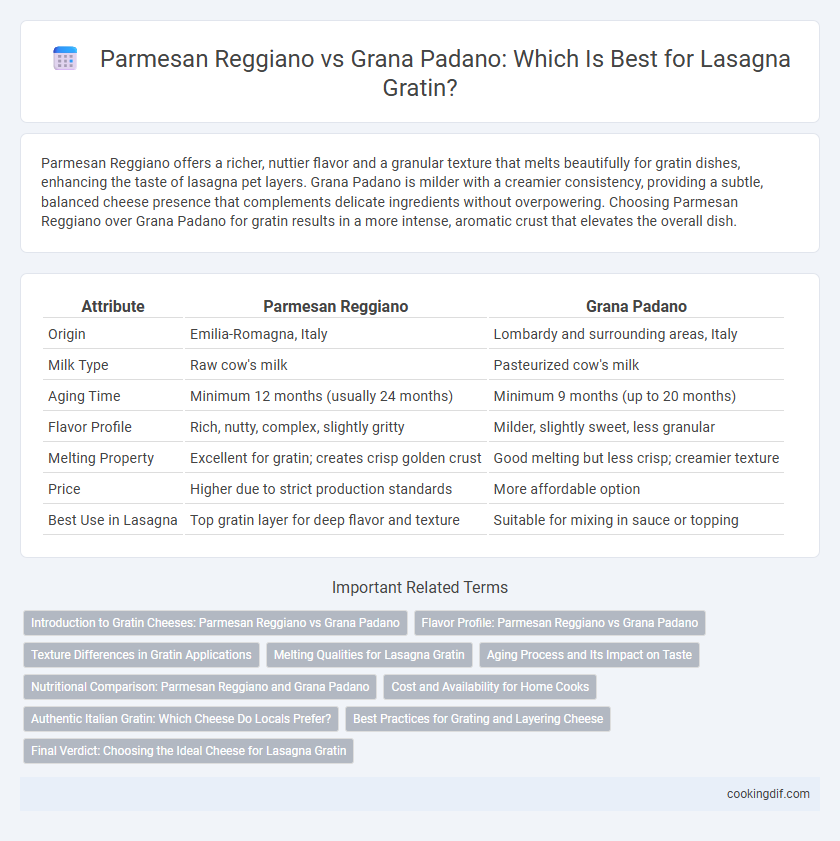Parmesan Reggiano offers a richer, nuttier flavor and a granular texture that melts beautifully for gratin dishes, enhancing the taste of lasagna pet layers. Grana Padano is milder with a creamier consistency, providing a subtle, balanced cheese presence that complements delicate ingredients without overpowering. Choosing Parmesan Reggiano over Grana Padano for gratin results in a more intense, aromatic crust that elevates the overall dish.
Table of Comparison
| Attribute | Parmesan Reggiano | Grana Padano |
|---|---|---|
| Origin | Emilia-Romagna, Italy | Lombardy and surrounding areas, Italy |
| Milk Type | Raw cow's milk | Pasteurized cow's milk |
| Aging Time | Minimum 12 months (usually 24 months) | Minimum 9 months (up to 20 months) |
| Flavor Profile | Rich, nutty, complex, slightly gritty | Milder, slightly sweet, less granular |
| Melting Property | Excellent for gratin; creates crisp golden crust | Good melting but less crisp; creamier texture |
| Price | Higher due to strict production standards | More affordable option |
| Best Use in Lasagna | Top gratin layer for deep flavor and texture | Suitable for mixing in sauce or topping |
Introduction to Gratin Cheeses: Parmesan Reggiano vs Grana Padano
Parmesan Reggiano and Grana Padano are two renowned Italian cheeses commonly used for gratin toppings, each offering distinct flavor profiles and textures. Parmesan Reggiano, aged longer and produced under stricter regulations, delivers a richer, nuttier taste with a granular texture that enhances the gratin's crispy, golden crust. Grana Padano, aged for a shorter period, provides a milder, creamier flavor, making it a versatile option for gratins that require a delicate cheese melt without overpowering other ingredients.
Flavor Profile: Parmesan Reggiano vs Grana Padano
Parmesan Reggiano offers a complex, nutty, and slightly fruity flavor with a granular texture that melts into a rich, savory gratin topping. Grana Padano provides a milder, creamier taste with a slightly less crumbly texture, resulting in a subtler, buttery finish. Choosing Parmesan Reggiano enhances lasagna with a more pronounced umami punch, while Grana Padano balances gratin by adding gentle depth without overpowering other ingredients.
Texture Differences in Gratin Applications
Parmesan Reggiano delivers a granular, crumbly texture that melts into a rich, slightly gritty gratin layer, enhancing the lasagna with a robust and savory bite. Grana Padano offers a slightly creamier and less granular texture, creating a smoother gratin that complements delicate pasta sheets without overpowering the dish. The choice between these cheeses affects the gratin's mouthfeel, with Parmesan providing a distinct, crumbly crispness and Grana Padano yielding a subtler, silkier finish.
Melting Qualities for Lasagna Gratin
Parmesan Reggiano offers a robust, nutty flavor and melts unevenly, creating crispy, golden gratin spots ideal for textured lasagna toppings. Grana Padano melts more uniformly with a milder taste, producing a creamier, smoother gratin layer that enhances lasagna's delicate balance of flavors. Choosing between Parmesan Reggiano and Grana Padano depends on whether a lasagna gratin needs a drier, textured crust or a consistent, creamy finish.
Aging Process and Its Impact on Taste
Parmesan Reggiano undergoes a minimum aging process of 12 months, often extending to 24 or 36 months, resulting in a more complex, nutty flavor ideal for gratin layers in lasagna. Grana Padano ages between 9 to 20 months, producing a milder, creamier taste that melts smoothly but lacks the intense sharpness of Parmesan Reggiano. The extended aging of Parmesan Reggiano intensifies its umami richness and granular texture, enhancing the gratin's crisp golden crust and savory depth in lasagna.
Nutritional Comparison: Parmesan Reggiano and Grana Padano
Parmesan Reggiano contains higher protein content and greater calcium levels than Grana Padano, contributing to stronger bone health and muscle maintenance. Both cheeses offer similar amounts of fat, but Parmesan Reggiano typically has a richer concentration of minerals like phosphorus and zinc, enhancing its nutritional profile. Calories remain comparable between the two, making either choice suitable for gratin toppings depending on dietary preferences.
Cost and Availability for Home Cooks
Parmesan Reggiano, known for its rich flavor and longer aging process, typically costs more and can be harder to find in regular grocery stores compared to Grana Padano, which is more affordable and widely available. Home cooks seeking a budget-friendly option for lasagna gratin often prefer Grana Padano due to its comparable texture and easy accessibility. Both cheeses melt well, but Grana Padano offers a practical balance of quality and cost for everyday cooking.
Authentic Italian Gratin: Which Cheese Do Locals Prefer?
Parmesan Reggiano, aged longer and produced in specific Italian provinces, delivers a robust, nutty flavor and granular texture that caramelizes beautifully for an authentic Italian gratin topping. Grana Padano, with a milder taste and shorter aging period, offers a creamier melt but less intense complexity preferred in casual or regional variations. Local Italians favor Parmesan Reggiano for traditional lasagna gratin due to its depth of flavor and superior browning qualities that define genuine Italian cuisine.
Best Practices for Grating and Layering Cheese
Parmesan Reggiano offers a stronger, nuttier flavor and a granular texture ideal for evenly grating over lasagna layers, while Grana Padano provides a milder taste and smoother finish suitable for delicate layering. Best practices for grating include using a fine microplane to achieve consistent shreds that melt uniformly throughout the dish. Layering cheese evenly between pasta sheets ensures balanced flavor distribution and optimal gratin browning during baking.
Final Verdict: Choosing the Ideal Cheese for Lasagna Gratin
Parmesan Reggiano offers a richer, nuttier flavor with a granular texture that crisps beautifully in lasagna gratin, enhancing the dish's complexity. Grana Padano, milder and creamier, melts smoothly and delivers a subtler taste, making it suitable for those preferring a less intense cheese profile. For the ideal lasagna gratin, Parmesan Reggiano is often favored for its bold, savory notes and superior browning, while Grana Padano serves as a versatile alternative balancing flavor and meltability.
Parmesan Reggiano vs Grana Padano for gratin Infographic

 cookingdif.com
cookingdif.com